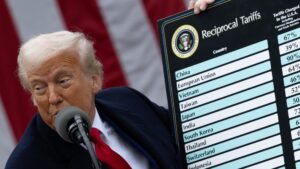The Challenges of Bringing Manufacturing Jobs Back to the U.S.: Insights from Extreme Investor Network
In recent years, discussions around reshoring manufacturing jobs to the United States have intensified, especially under the banner of former President Donald Trump’s tariffs aimed at incentivizing domestic production. However, a closer look reveals that the dream of a manufacturing renaissance may be more complex than anticipated, as highlighted in a recent analysis by Wells Fargo.
The Reality of Reshoring
As firms contemplate bringing factory work back to U.S. soil, they face a stark reality: labor costs soar. Wells Fargo points out that for many companies, absorbing or passing on these increased expenses may not be viable in today’s tight labor market. This isn’t just an economic abstraction—it’s a tangible obstacle that can stifle growth. Sarah House, a senior economist at Wells Fargo, articulated the concern in her report, stating, “A meaningful increase in factory jobs does not appear likely in the foreseeable future.” With job expansion policies being clouded by uncertainty and rising prices, firms may be hesitant to commit to expanding payroll.
Tariffs: A Double-Edged Sword
The tariffs that have raised the effective rate on importers to levels unseen since the 1940s were designed to protect domestic manufacturing and spur job growth. However, these tariffs can also raise costs for both consumers and businesses. The trade war, while generating some high-profile commitments from tech giants like Nvidia and Apple, poses significant challenges. Nvidia’s plans for a supercomputer plant and Apple’s $500 billion investment are indeed steps in the right direction, but they may not be enough to reverse the long-term trends of job losses in manufacturing.
The Harsh Numbers
To put things into perspective, America currently has 12.8 million manufacturing jobs—6.7 million fewer than its peak in 1979. To reach that golden era, approximately 22 million new jobs would need to be created, while only 7.2 million Americans are currently unemployed. This stark disparity highlights the uphill battle ahead. Wells Fargo emphasizes that restoring U.S. manufacturing employment to historical levels will require not just strategic policies but also innovation and a rethinking of operational models.
Embracing Innovation Over Tradition
At Extreme Investor Network, we believe that while reshoring presents challenges, it can also drive innovation. Companies might need to invest in technology that streamlines processes, reduces reliance on labor, and increases operational efficiency. Automation and advanced manufacturing techniques could allow businesses to thrive even in a costly labor market, potentially creating new job categories that weren’t previously imagined.
Washington’s Role in the Future of Manufacturing
The administration’s focus on bringing jobs back home is commendable; however, the complexities of the modern economy require a multi-faceted approach. Policymakers must consider tax incentives, workforce training, and support for emerging technologies to create an environment conducive to job growth. These steps are essential for ensuring that American manufacturing can compete on a global scale.
Conclusion
The pursuit of reviving U.S. manufacturing is not merely a matter of policy but a complex balancing act involving economics, technology, and workforce dynamics. As we navigate these turbulent waters, it’s crucial for investors, business leaders, and policymakers to unite in fostering an environment where manufacturing can flourish. At Extreme Investor Network, we are committed to providing insights and support for those looking to invest strategically in this evolving landscape. The journey may be steep, but the rewards could be monumental.
Stay tuned for more expert insights from Extreme Investor Network as we continue to explore the intricacies of finance and investment strategies in today’s fast-paced economy.

